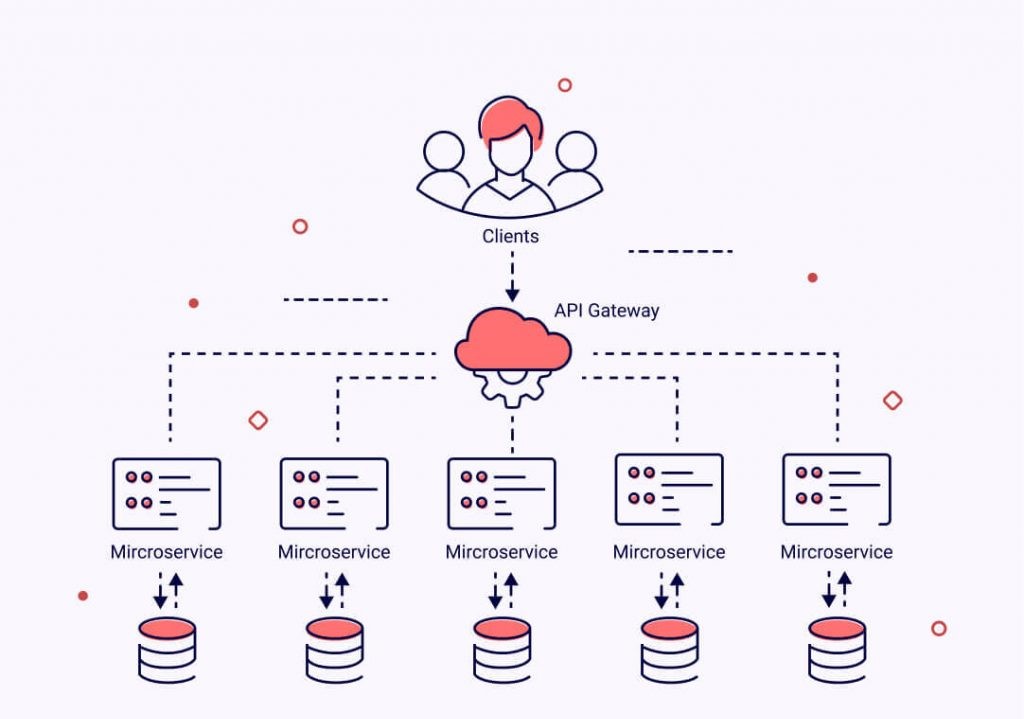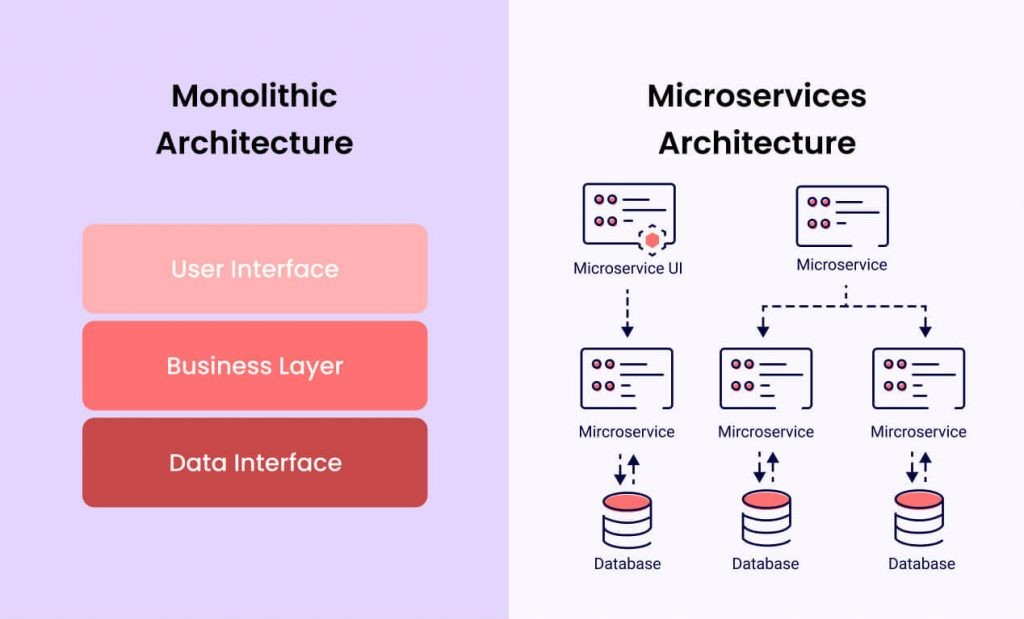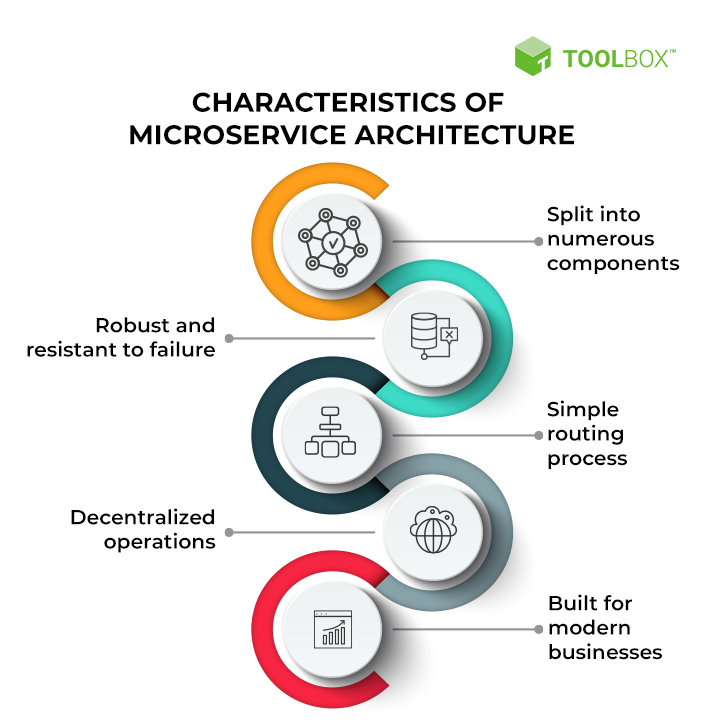Table of Contents
Project Description: Coin Compass is a microservice project designed to predict cryptocurrency prices using machine learning algorithms. It will integrate with various cryptocurrency data sources and leverage machine learning models to generate price forecasts for different time horizons.
- Develop a machine learning model capable of predicting cryptocurrency prices with acceptable accuracy.
- Design and implement a microservice architecture for real-time and efficient prediction delivery.
- Integrate with relevant cryptocurrency data sources to ensure access to historical and current market data.
- Provide an API for easy integration with other applications and platforms.
- Offer customizable prediction options based on user-defined parameters.
System uses a Microservice architecture. But what are a Microservice?
A system is usually built in a Microservice or in a Monolith architecture manner.
The microservice architecture, is a way of developing software that breaks down a large application into smaller, independent services. Each service has its own specific function and communicates with other services through well-defined interfaces, typically APIs. Here's a breakdown of the key characteristics:
This describes a single, unified software application containing all the features and functionalities within itself. Think of it as a large building with everything under one roof. It's typically self-contained and independent from other applications. While simple to understand and manage initially, monolithic applications can become cumbersome and challenging to maintain and scale as they grow in complexity.
-
Split into numerous components: Instead of a single large application, the system is divided into independent, small services each performing a specific task. These services communicate through well-defined APIs -
Robust and resistant to failure: Each service is designed to be isolated and self-contained, minimizing the impact of failures on the whole system. -
Simple routing process: The system utilizes a clear and efficient mechanism for directing requests to the appropriate service. This could involve API gateways, service meshes, or other routing strategies. -
Decentralized operations: Each service can be managed and deployed independently, allowing for different teams and technologies to be used. -
Built for morden business: Microservices architecture aligns well with the flexible, dynamic, and scalable needs of modern businesses.
The fundamental building blocks of the entire system comprises 8 microservices with each services managing a particular task below each service explained
an API Gateway acts as the "front door" to your system, mediating the flow of requests between clients (like mobile apps or websites) and your various backend services.
Single entry point: Clients interact with the API Gateway using a single, well-defined API instead of needing to know and connect to individual services directly. This simplifies client development and integration.Traffic routing: The API Gateway receives requests, identifies the appropriate target service based on defined rules (e.g., URL, headers), and routes the request accordingly.Protocol translation: It can act as a translator between different protocols used by clients and services, ensuring seamless communication despite variations.Security enforcement: The API Gateway can implement security policies, throttling, and authentication/authorization checks before forwarding requests to services, enhancing overall system security.Monitoring and analytics: It can collect and analyze data about incoming requests and responses, providing insights into API usage and system performance.
An Auth Service utilizing JWT (JSON Web Token) for role-based security plays a crucial role in managing user access and authorization. Here's a breakdown of its functionalities and considerations:
User registration and authentication: Provides secure user registration and login options, potentially integrating with social media logins.JWT token generation: Upon successful authentication, generates a signed JWT token containing user information and assigned roles.Token validation: Validates incoming JWT tokens from other services, verifying their authenticity and expiration.Role-based access control (RBAC): Associates user roles with specific permissions and enforces access restrictions based on these roles.Token refresh: Offers mechanisms to refresh expiring tokens without requiring users to re-authenticate.
A Config Service acts as a central repository for all configuration settings needed by your individual services. This approach offers several advantages over hardcoding configurations within each service, leading to better maintainability, flexibility, and centralized control.
Configuration storage: Securely stores configuration data for various aspects of your services, including API keys, database connections, logging levels, feature flags, and other environment-specific settings.Dynamic configuration updates: Allows updating configurations without requiring individual service deployments, improving agility and reducing downtime.Versioning and rollbacks: Supports configuration versioning and rollback capabilities to enable reverting to previous configurations if needed.Access control and security: Implements access control mechanisms to restrict who can modify configurations and ensures secure access to sensitive data.
A Crypto Service responsible for connecting to Binance and retrieving real-time candlestick data plays a crucial role in generating timely predictions. Here's a breakdown of its functionalities and considerations:
Connection establishment: Securely connects to the Binance API using appropriate authentication and authorization mechanisms.Data retrieval: Fetches real-time candlestick data for desired cryptocurrencies and timeframes specified by the system or user requests.Data filtering and pre-processing: Cleans and filters the raw data to ensure consistency and suitability for further processing.
A Favorite Service in your Coin Compass project could act as a bookmarking system for users to keep track of their preferred cryptocurrencies. Here's how it might function:
Adding favorites: Users can add cryptocurrencies to their personal list of favorites, potentially through an API or user interface.Managing favorites: Users can view, edit, or remove entries from their favorite list.
A Predict Service that takes crypto candle sticks and predicts price is a key component of your envisioned Coin Compass project. Here's a breakdown of its potential functionalities and considerations:
Data input: Receives cryptocurrency candlestick data as input, which typically includes information like opening and closing prices, high and low prices, and trading volume for a specific timeframe.Model access: Accesses and utilizes a trained machine learning model specializing in cryptocurrency price prediction.Prediction generation: Based on the input data and the trained model, generates price predictions for a specified future timeframe.Customization: Might offer options to customize predictions based on different parameters like prediction horizon, technical indicators, or specific cryptocurrencies.Output format: Outputs the generated predictions in a structured format, potentially including confidence scores or prediction ranges.
Comprises a single POST endpoint - api/v1/predict
To use this project, simply run the crypto.py script:
python crypto.py This will load the data, train the model, and generate the predicted vs actual volume graph.
The dataset used in this project is the Cryptocurrency Historical Prices dataset, which contains historical prices for various cryptocurrencies. Dataset source here https://www.kaggle.com/datasets/sudalairajkumar/cryptocurrencypricehistory?resource=download
The supervised learning model used in this project is the Linear Regression model from the Scikit-learn library. This model is trained on the previous cryptocurrency volume data to predict the future volume.
The graph shows the predicted volume vs the actual volume for the cryptocurrency. This graph is generated using the Matplotlib library.
- Second graph out put
A Profile Service specifically designed to manage user data like name, date of birth (DOB), and other personal information would typically handle the following functionalities:
Storing user data: It securely stores user information like names, addresses, DOBs, contact details, preferences, and other relevant data based on the application's requirements.Data access and updates: Provides controlled access to authorized users or applications to retrieve, update, or delete user profiles or specific data elements.Data validation and security: Implements validation rules to ensure data accuracy and adheres to security best practices for user data protection.
A Service Registry acts as a centralized directory for all the individual services within the system. It stores information about each service, including its:
Name: Unique identifier for the service.Location: Hostname and port number where the service is running.Health status: Whether the service is currently healthy and accepting requests.Metadata: Additional information about the service, such as its capabilities and version.
The microservices are built using below technologies
Languages: Java, Python, SQL, NoSQL
Frameworks: Spring Boot, Flask, Sklearn
Database: MySQL, MongoDB
Tools: Docker, Postman, Anaconda
You should have the below software installed in your pc :
- Python3
- Java 21
- Anaconda
- Flask
- XAMPP 8
- MongoDB
- and your preferred IDE or text editor
-
Get a free API Key at https://github.com/settings/tokens
-
Clone the repo
git clone https://github.com/kudzaiprichard/coin-compass.git
-
Open project in desired IDE or text editor
For the predict service: flask, python
-
Create a python environment
python -m venv myenv
-
Activate created environment
source myenv/bin/activate -
Install required python packages
pip install -r requirements.txt
-
You can now run the system using below flask command
flask run
For the other services, java, spring boot
- Open the services with IDE or Text editor
- Maven will load the project packages and project configurations
NB: make sure your connected online
If you have a suggestion that would make this better, please fork the repo and create a pull request. You can also simply open an issue with the tag "enhancement". Don't forget to give the project a star! Thanks again!
- Fork the Project
- Create your Feature Branch (
git checkout -b feature/AmazingFeature) - Commit your Changes (
git commit -m 'Add some AmazingFeature') - Push to the Branch (
git push origin feature/AmazingFeature) - Open a Pull Request
Your contributions are always welcome and appreciated. Following are the things you can do to contribute to this project.
-
Report a bug
If you think you have encountered a bug, and I should know about it, feel free to report it here and I will take care of it. -
Request a feature
You can also request for a feature here, and if it will viable, it will be picked for development. -
Create a pull request
It can't get better than this, your pull request will be appreciated by the community. You can get started by picking up any open issues from here and make a pull request.
If you are new to open-source, make sure to check read more about it here and learn more about creating a pull request here.
Distributed under the MIT License. See
LICENSE.txtfor more information.
Kudzai P Matizirofa - linkedin.com/in/kudzai-prichard - kudzaiprichard@gmail.com
Project Link: https://github.com/kudzaiprichard/coin-compass.git
list of resources I found helpful and would like to give credit to.






